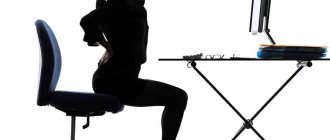Many of us have heard that a sedentary lifestyle is life-threatening. There are many studies on this topic that show that sitting for long periods of time increases the risk of cardiovascular disease and mortality from it, as well as type 2 diabetes and even cancer. This is especially alarming to hear given that over the past few months, many people in Russia and other countries have been more sedentary than ever. Even before the COVID-19 outbreak, many of us had largely eliminated physical activity from our lives. And now the pandemic has only made the situation worse. Fewer trips outside, no gym, working from home and countless hours of Zoom calls meant we were sitting for most of the day.
It might be better to read this article on the go.
Which is better to work - sitting or lying down?
How to deal with this is still unclear. Obviously, we need to return to normal life, but doing this at once is not so easy. And many quite logically ask the question: if working while sitting is so harmful to health, can the situation be improved by taking a lying or reclining position? Instead of sitting upright (or slouching) at your desk all day, wouldn't it be better to lie down on the sofa, or relax in a hammock, or lean back in your chair? After all, your body will be positioned differently. Scientists say it doesn't matter.
It’s high time to add to the “sedentary lifestyle” not only sitting, but also everything that is associated with a low level of energy consumption. Including lying and reclining positions. They are no more beneficial than sitting in a chair all day, says Arthur Veltman, a professor of physiology at the University of Virginia (USA).
It doesn’t matter how or where you sit - this lifestyle is harmful to your health.
Exercises for a sedentary lifestyle
When all the tips and recommendations have been exhausted, although you can come up with a lot more, all that remains is to figure out which gymnastics at work with a sedentary lifestyle is optimal for your goals, and which exercises can be done at home.
At work: without leaving your desk
It is optimal to make such exercise your daily ritual. You shouldn’t be afraid or embarrassed by the puzzled looks of your colleagues, because it’s your health. If you do not take care of it today, then tomorrow it can present you with many unpleasant surprises. Therefore, uncomprehending glances are the least of evils.
- Sit back in your chair if it's fairly comfortable. Stretch both legs forward, and then alternately bend one or the other at the knee. It is important not to lower your feet to the floor, but to keep them suspended. 10-20 repetitions for each limb will be quite enough.
- Lower one leg, extend the other, and stretch your toes forward. Make circular movements first clockwise and then counterclockwise. Repeat with the other leg, 10-15 times for each is just enough.
- Rotate your shoulders first forward ten times and then back. Keep your back straight.
- Slowly rotate your head clockwise and then counterclockwise (it is better not to do this exercise if you have cervical osteochondrosis).
- Spread your arms out to the sides so that they form a horizontal line. Stretch up with the top of your head, while simultaneously bending one arm at the elbow, placing it behind your head, and touching the opposite shoulder. You need to perform 15-20 repetitions alternately with each hand, and then the same number with both.
- While sitting, tighten your buttock muscles as much as possible. Hold the position for a few seconds and then relax. Repeat 20-30 times.
- Place your palms in front of your chest, as if in a pleading gesture. Press them together forcefully, fix the position for 10-15 seconds, relax. Repeat up to 10 times.
- Clench and unclench your fists for a few seconds, then clasp your fingers and stretch upward.
- Lower your arms along your body and shake them.
- Moving slightly back from the table, lean your whole body forward, simultaneously bringing your shoulder blades together. 5-10 repetitions are enough.
- Sit on the very edge of an office chair or chair, straighten your back, pull in your stomach and tighten your abdominal muscles. This exercise must be repeated 40-50 times, otherwise it will not have any effect.
- As you inhale, sharply raise your shoulders, and as you exhale, quickly lower them. You need to do 10-15 repetitions.
- Sit with your feet completely flat on the floor, preferably taking off your shoes. Alternately lift your toes and heels off the floor. Repeat 20-30 times.
- Take a cylindrical object, for example, a glue stick, and roll it with your feet on the floor surface for 2-3 minutes.
Lastly, stretch your legs forward, lean forward as much as possible, while trying to reach your toes with your fingertips.
At home
Since a sedentary lifestyle involves a lot of stress on the legs, spine, and internal organs, it’s not a bad idea to work out/stretch these areas during home workouts.
- Stand straight, feet shoulder-width apart, arms along your body. Slowly move your pelvis back while maintaining the natural curve in your back. In this case, your legs need to be slightly bent at the knees. It is assumed that you need to perform at least 40-60 repetitions.
- Take a wide step forward, as if in a lunge, so that your leg forms a sharp angle at the knee. Rotate your body in the opposite direction so that you feel the tension in the muscles in your hips. Return to the starting position. Repeat on each leg 15-20 times.
- While standing, perform the mill exercise, that is, alternately raise your outstretched arms over the front and lower them as much as possible in the opposite direction. You can do this any number of times for 3-5 minutes.
- Standing straight, feet shoulder-width apart, perform 20-25 swings back and forth and to the side. Repeat the same amount for both legs. In this case, you can keep your hands on your belt, or you can put them behind your head.
- As you exhale, bend your body forward without rounding your back or bending your legs, and as you inhale, return to your original position. The feet are shoulder-width apart and the hands are on the waist. Repeat 20-25 times.
- Raise your arms to a horizontal position, bend your elbows, palms in front of your chest, with the insides facing down. Make jerking movements, trying to bring your shoulder blades together as much as possible. At the same time, you can rotate the body left and right alternately.
These are basic movements that can be greatly varied if desired. For example, you can train yourself to always do morning exercises, go jogging regularly, and also choose any active activity of your choice. Many people play football, basketball, go to the pool, dance and practice martial arts. Everything here is very individual, the main thing is not to sit still during your free time from work, otherwise you will definitely not like the consequences.
Physical activity and health
Does physical activity really help reduce or even eliminate the negative effects of sedentary behavior? The 2020 study analyzed data collected from more than 1 million men and women. Those who sat a lot and were not physically active had the highest risk of death from all causes. Those who sat little and had high levels of moderate to vigorous physical activity had the lowest risk of mortality.
What about the "golden mean"? For example, if an office clerk spends 9-10 hours sitting at work, and then spends the evenings in the gym (or, conversely, goes there in the morning). Research shows that mortality risk decreases as physical activity increases, regardless of how much you sit . That is, you can completely compensate for a sedentary lifestyle with walks and physical activity.
HARMS OF A SEDIENT LIFESTYLE
Researchers claim that the first preconditions for the emergence of a sedentary lifestyle arose in the 18th century. It was then that an invention appeared that created the precondition for the industrial revolution . It was a mechanical spinning wheel. The logic of thinking is clear: the gradual transition from manual labor to machine labor and the improvement of technology have increased the quality of life of people, thereby reducing the need to move.
Steamships, steam locomotives, cars, and elevators appeared. And the technological breakthroughs of the 20th century and the computer revolution finally tore most workers away from their machines and sat them at the office desk. And now, already in the 21st century, a sedentary lifestyle has become a powerful threat to people's health.
Inactivity
is a worldwide problem. According to scientists, the average Danish resident sits in a chair for 7 hours a day, and a Chinese citizen sits in a chair for 8.5 hours. According to a 2020 English study, office workers spend between 70 and 85% of their working time sitting; and a 2012 study even reports the figure “up to 15 hours a day.” This is due to the fact that low levels of a person’s energy consumption at work are complemented by a lack of activity at home - watching TV, working at a desk. Doctors have long sounded the alarm about this: excessive sitting provokes serious health risks, including cardiovascular disease, diabetes and even premature mortality. The medical name for this phenomenon is physical inactivity, i.e. disruption of body functions by limiting physical activity and reducing the strength of muscle contraction.
HARMS OF SENANCY
In 2013, Australian doctors conducted a large-scale study, the results of which showed a direct connection between prolonged periods without movement (literally sitting) and increased anxiety, as well as the development of depressive conditions.
Other work from the University of California found that sedentary behavior is associated with thinning of areas of the brain that are critical to the ability to remember new information. Low activity doubles the risk of diabetes because without movement the body reduces its ability to remove glucose from the blood. Calories are also not burned (calorie consumption while sitting is 1 per minute!) - and the person rapidly gains weight, which ultimately leads to problems with the cardiovascular system. At the same time, the system also suffers directly: when a person sits, the heart makes less productive contractions, which reduces the tone of the vascular walls. The enormous load on the spine when sitting can lead to complications in the form of back and neck pain, and also lead to disc compression in the lower spine. In addition, sufficient body movement tells the body that constant renewal of cells and tissues is necessary. Otherwise, such a signal does not occur, and bone fragility increases, which can lead to osteoporosis. A 2014 study by the Oxford National Cancer Research Institute found that low mobility was associated with an increased risk of developing colon or uterine cancer by 8% and 10% respectively. Tireless Britons also found that a sedentary lifestyle can lead to blood clots. In addition, sitting in one place for a long time provokes stagnation of blood and lymph in the pelvic organs, negatively affecting the functioning of the genitourinary system.
WHAT TO DO?
A large 2020 study conducted by a team of scientists based on data from more than a million people provides this answer. To avoid early death associated with the risks of heart and vascular diseases, you need to give yourself at least 60-75 minutes of moderate cardio exercise per day. The following conclusion is also obvious: structure your work and life in general in such a way as to reduce the sitting position to a minimum. You can avoid diseases caused by physical inactivity if you lead a healthy lifestyle. It is advisable to consult a specialist to start playing sports without harm to your health.
In combination with physical activity, multivitamins aimed at supporting the bone system (calcium), eliminating mood disorders associated with physical inactivity, and general strengthening vitamin-mineral complexes will also be very useful.
“Planet Health” suggests paying attention to the English line VIVACIA
, in particular, on
Zinc Magnesium & Vitamin B6
.
The complex is designed to increase the body's endurance, improve and activate the immune and nervous systems. Magnesium and zinc in the composition help cope with emotional stress, and also maintain electrolyte balance when playing sports. Vitamin B6 in combination with magnesium has a positive effect on the nervous system, mitigating the effects of psycho-emotional stress, and strengthens the body's protective functions. VIVACIA Zinc Magnesium & Vitamin B6
is ideal for activating vitality, raising your mood and self-confidence, reducing fatigue caused by a sedentary lifestyle, and providing reliable support for beauty and health.
BIOLOGICALLY ACTIVE SUPPLEMENT. NOT A MEDICINE.
How much exercise should you do per day?
What kind of activity do you need? The generally accepted estimate is that a person should get 60 to 75 minutes a day of moderate activity or 30 to 40 minutes of vigorous activity. The first means a regular intense walk, and the second means physical exercise. It is enough to choose at least one thing.
WHO defines physical activity as any body movement that requires energy expenditure. That is, any movement during work matters, be it doing housework or walking around the neighborhood. But exercise is much more effective. This is a form of physical activity aimed at improving flexibility and organ condition, along with cardio and muscular fitness. This is one of the best ways to improve your health and quality of life.
Such exercise provides a lower risk of mortality from many causes: heart disease, stroke, type 2 diabetes, cancer, obesity, hypertension and osteoporosis. Your brain health will also improve - perhaps enough to prevent depression, anxiety, dementia and Alzheimer's disease.
You can try to work while standing, but without physical activity there is little point in doing so.
And you'll sleep better.
Morris and the bus drivers
It has long been known that even mild physical activity, such as walking or simply standing, is beneficial. Even 2,400 years ago, Hippocrates warned against excessive sitting and emphasized that any movement for the body is of great importance. Already in our times, in the middle of the twentieth century, the Scottish scientist Jeremy Morris pointed out that sitting poses a threat to health. In a study of London bus drivers and conductors, he found that seated drivers had twice the risk of a heart attack compared with conductors. In addition, heart attacks among drivers were more extensive and serious and, compared to conductors, were twice as likely to result in death. The scientist observed a similar picture among postmen: those who sat at a desk in the office got sick more often than those who rode a bicycle or delivered mail on foot. Morris was a pioneer in studying the influence of physical activity on susceptibility to disease, and the results of his work are still relevant today. He took his research seriously and subsequently began to adhere to certain rules regarding physical activity. Even at the age of 90, Jeremy Morris practiced walking, cycling, and swimming at least 30 minutes a day. He died several years ago, a couple of months before his hundredth birthday.
Everyone can stand up for at least a minute, even those who don’t like to make unnecessary movements.
What are the dangers of lack of sleep?
The previously mentioned “sedentary lifestyle” does not include sleep. Sleep is absolutely essential to staying healthy. Many people suffer from lack of sleep and get less than six hours a day. But is it worth it? Difficulties with behavior, emotional control, decision making and problem solving are just some of the consequences of lack of sleep at any age.
Poor sleep can also have a negative impact on the immune system in people of all ages, leading to increased vulnerability to infections. It also contributes to obesity; Essentially, sleep deprivation increases the “hunger hormone” (ghrelin) in your body and decreases con (leptin). You start to want to eat, and the risk of overeating increases.
Without enough sleep, the risk of obesity increases
Use massage capes
Treat yourself to a massage any time you want - and not once every six months by appointment. Massage covers can be easily attached to the back of any seat - on an office chair, a home chair or in a car. Just 15-20 minutes of operation of such a device, and you will be as good as new: relieve tension, normalize muscle tone, get rid of unnecessary pain, improve blood circulation and simply feel lighter. Such capes are usually connected to a standard outlet, and in a car - to the on-board power supply.
The universal massage cape Belberg Neo Driver BM-03 is suitable for any seat and fits perfectly on any surface. Thanks to three dozen air chambers, you will receive a useful and relaxing air compression massage. You will have six massage programs, a timer, intensity settings and other useful functions at your disposal. Well, in the end, it’s just very nice.
How much sleep do you need per day?
Physical activity and good sleep go hand in hand. Moderate to vigorous activity can help you fall asleep faster and get deeper sleep.
In adults, lack of sleep is associated with an increased risk of heart disease, high blood pressure, stroke and kidney disease. Adults need 7 to 8 hours of sleep per day .
Children also suffer when they don't get enough sleep. Lack of sleep slows down the production of growth hormone. Teenagers need 8-10 hours of sleep , and children 6-12 years old need 9-12 hours .
Research on sedentary behavior is not yet complete. There are no final recommendations that all scientists would accept yet. But it's reasonable to assume that skipping sleep is a bad idea. Do more physical activity and exercise. Sit less. And when you are sitting at your desk or about every half hour, get up for a few minutes and take a break for a short walk. You can even read our Yandex.Zen while you walk. See how your condition changes.
Don't rest while sitting or lying down
It's scary to admit it, but the armchair, sofa, chair and bed are your main enemies at home. It turns out that they are slowly killing even those who regularly train in the gym or run outdoors (their consequences will simply not be as severe). People who rest primarily while sitting are more susceptible to developing a variety of diseases. Here you have diabetes, oncology, and other troubles. The solution is to get up from time to time. At least every half hour. Even better - reduce the time you spend resting in a chair or bed as much as possible (two to three hours is ideal). TV lovers can place even the simplest exercise machine next to it and exercise while watching their favorite show. And if buying sports equipment is not yet part of your plans, don’t be lazy to take a couple of minutes for yourself while the advertising is on - get up and stretch. Taking care of yourself is much easier than it seems.
Back Next
How to deal with a sedentary lifestyle?
Now let's find out how to overcome this unpleasant and dangerous habit. Oddly enough, this can be done with movement, or rather with sufficient mobility. Muscles require at least a minimal load, otherwise you will not be able to avoid the accumulation of fatty deposits, much less lose weight.
To maintain tone, people with sedentary work need to periodically take a break for a couple of minutes for simple physical activity. This will prevent your legs from getting numb, allowing you to burn calories and warm up. This way you will normalize blood circulation, breathing, and receive a small boost of energy for further work. Try these simple gymnastics, which are suitable for warming up at the workplace:
tilting and turning the head to the sides; stretching your head and arms forward while sitting on a chair; straightening the back: we put our hands in a lock behind, and we reach for the ceiling with our chin; sitting on a chair, lower your torso to your knees and lower your head; in a sitting position, clasp your arms around the back of the chair and straighten your chest; stretch your arms up; standing in front of a chair, grab the back with your hands and bend over so that your torso is parallel to the floor; While standing, bend your torso to the sides.
This minimal set of gymnastic exercises will allow you to warm up, but this is not enough to lose weight with a sedentary lifestyle. You will have to take up more serious sports: join a gym, start running, cycling or roller skating, go to fitness. All this will allow you to avoid dangerous consequences and maintain your health, even if you work while sitting in the office.
What are the dangers of a sedentary lifestyle?
//
In people who lead a sedentary lifestyle, their metabolism sharply decreases due to insufficient oxygen entering the body. This leads to many troubles: premature development of atherosclerosis, heart attacks and strokes, lung diseases... With physical inactivity, obesity occurs, and calcium is lost from the bones. For example, as a result of three weeks of forced immobility, a person loses as much minerals as in a year of his life. Physical inactivity leads to a decrease in the micropumping function of skeletal muscles, and the heart thereby loses its reliable helpers, which leads to various circulatory disorders in the human body and cardiovascular diseases.
At rest, about 40% of the blood does not circulate throughout the body and is in the “depot”. Consequently, tissues and organs are less well supplied with oxygen - this elixir of life. And vice versa, during movement, blood from the “depot” actively enters the vessels, as a result of which metabolism increases and the human body is faster freed from toxins.
For example, in muscles at rest, only 25-50 capillaries function (per 1 mm2 of tissue). In a working muscle, up to 3000 capillaries actively pass blood through themselves. The same pattern is observed in the lungs with alveoli.
Muscle inaction leads to poor circulation in all organs, but the heart and brain suffer most often. It is no coincidence that patients forced to remain on bed rest for a long time first of all begin to complain of colic in the heart and headache. Previously, when patients with myocardial infarction were not allowed to move for a long time, the mortality rate among them was much higher. Conversely, when they began to practice an early motor regimen, the percentage of recovery increased sharply.
A sedentary lifestyle also leads to premature aging of the human body: muscles atrophy, vitality sharply decreases, performance becomes impaired, early wrinkles appear, memory deteriorates, dark thoughts haunt you... Therefore, longevity is impossible without an active lifestyle.
Scientists have published many works indicating that a sedentary lifestyle contributes to the development of tumor diseases.
But training the body for physical activity, on the contrary, has a positive effect on the function of all organs and systems and increases a person’s reserve capabilities. Thus, under the influence of physical exercise, the elasticity of blood vessels increases, their lumen becomes larger. First of all, this applies to the vessels that supply blood to the heart muscle. Systematic exercise and sports prevent the development of vascular spasms and thereby prevent angina pectoris, heart attack and other heart diseases.
To prevent blood stagnation in the body, it is necessary to “forcibly” redistribute it between the limbs and internal organs. What needs to be done for this? Force yourself to exercise regularly. For example, when working sedentarily, get up more often (several times an hour), bend over, squat, etc., breathe deeply, and after work, walk at least part of the way home. At home, it is useful to lie down for ten minutes with your legs elevated.
We should not forget that the older a person is, the fewer functioning capillaries remain. However, in constantly working muscles they are preserved. In functioning muscles, blood vessels age much more slowly than in internal organs. For example, the blood vessels in the legs age the fastest due to poor blood flow resulting from defective vein valves. This leads to stagnation of blood, dilation of veins and chronic oxygen starvation of tissues with the formation of blood clots and trophic ulcers. Therefore, it is necessary to give the leg muscles a feasible load throughout your entire life, alternating it with periods of rational rest.
In a person who does not systematically engage in physical exercise, by the age of 40-50 years of life, the speed of blood flow noticeably slows down, muscle strength and depth of breathing decrease, and blood clotting increases. As a result, among such people the number of patients with angina pectoris and hypertension is sharply increasing.
At the same time, older people leading an active lifestyle and pensioners who continue to work hard do not experience a sharp deterioration in their health.
Unfortunately, many older people play it safe too much, being afraid to go outside again, limit their movements, and avoid even strenuous exercise. As a result, their blood circulation sharply worsens, the respiratory excursion of the lungs decreases, the emptying of the alveoli increases, pneumosclerosis rapidly progresses, and pulmonary heart failure occurs.
The sedentary lifestyle of modern man has become one of the main causes of early atherosclerosis, pneumosclerosis, coronary heart disease and sudden death.
Numerous animal experiments indicate the same. For example, birds released from cramped cages, rising into the air, died from heart failure. Even nightingales raised in captivity died with strong trills when released. This can happen to a person who leads a sedentary lifestyle.
To maintain the functioning of all organs and systems throughout life, a person must first take care of proper breathing. It has been established that the pulmonary artery and its inner lining, with sufficient inhalation of oxygen, activate the functions of certain hormones. This, in particular, is the basis for treatment with oxygen, oxygen foam, as well as aromas of a number of flowers.
When there is insufficient oxygen supply to the human body as a result of shallow breathing, oxidative processes are disrupted with the formation of under-oxidized products with so-called free radicals. They themselves are capable of causing prolonged spasm of blood vessels, which is often the cause of mysterious pains in various parts of the body.
Any weakening of breathing, no matter what it is caused by - improper breathing or low physical activity - reduces oxygen consumption by the body's tissues. As a result, the amount of protein-fat complexes in the blood increases - lipoproteins, which are the main sources of the formation of atherosclerotic deposits in the capillaries. For this reason, lack of oxygen in the body accelerates the development of atherosclerosis in relatively young people. age.
It has been noted that people who lead a sedentary lifestyle and avoid physical labor often suffer from colds. What's the matter? It turns out that their lung function is reduced.
The lungs, as is known, consist of tiny bubbles filled with air - alveoli, the walls of which are densely intertwined with blood capillaries in the form of a very thin network. When you inhale, the alveoli, filling with air, expand and stretch the capillary network. This creates conditions for better filling them with blood. Consequently, the deeper the inhalation, the more complete the blood supply to both the alveoli and the lungs in general.
In a physically developed person, the total area of all alveoli can reach 100 m2. And if all of them are included in the act of breathing, then special cells - macrophages - freely move from the blood capillaries into the lumen of the alveoli. They protect the alveolar tissue from harmful and toxic impurities contained in the inhaled air, neutralize microbes and viruses and neutralize the toxic substances they release - toxins.
The life of these cells, however, is short: they quickly die from inhaled dust, bacteria and other microorganisms. And the more polluted the air inhaled by a person is with dust, gases, tobacco smoke and other toxic combustion products, in particular exhaust gases from vehicles, the faster the macrophages that protect us die. Dead alveolar macrophages can be removed from the body only with good ventilation.
And if, with a sedentary lifestyle, a person breathes shallowly, then a significant part of the alveoli does not participate in the act of breathing. The movement of blood in them is sharply weakened, and these non-breathing areas of the lungs have almost no protective cells. The resulting ones are defenseless. zones are the place where an unimpeded virus or microbe enters, damages the lung tissue and causes disease.
This is why it is so important that the air you breathe is clean and oxygenated. It is better to inhale through the nose, where it is cleared of germs and dust, warmed and moisturized, and exhalation can also be done through the mouth.
Do not forget that the deeper you inhale, the larger the area of the alveoli is involved in gas exchange, the more protective cells - macrophages - enter them. People who lead a sedentary lifestyle need to regularly practice deep breathing in the fresh air.
In case of inflammatory diseases of the respiratory system, on the advice of a doctor, you need to do breathing exercises to prevent the alveoli from shrinking and to prevent their death. At the same time, we should not forget that lung tissue is capable of regeneration, and lost alveoli can be restored. This is facilitated by deep breathing through the nose, involving the diaphragm, which obese people who lead a sedentary lifestyle should not forget about.
A person can control his breathing, change its rhythm and depth. During breathing, nerve impulses emanating from both the lung tissue itself and the respiratory center affect the tone of the cerebral cortex. It is known that the process of inhalation causes excitation of the cells of the cerebral cortex, and exhalation causes inhibition. If their duration is equal, these influences are automatically neutralized.
To give vigor, breathing should be deep, with accelerated exhalation, which will also contribute to increased performance. By the way, this principle is clearly visible in the example of chopping wood: swinging an ax - take a deep breath, hitting a log - short, energetic exhale. This allows a person to perform similar work for quite a long time without rest.
But a short inhalation and an extended exhalation, on the contrary, relax the muscles and calm the nervous system. This breathing is used to transition from wakefulness to a state of rest, rest and sleep.
The opening of the alveoli is also facilitated by an increase in intrathoracic pressure. This can be achieved by inflating, for example, a rubber toy or a ball bladder. You can also do it with effort, exhaling through your lips, extended forward and folded into a tube, pronouncing the letters “f” or “fu”.
A good breathing exercise is cheerful, playful laughter, which simultaneously massages many internal organs.
In a word, in order to neutralize the harmful effects of a sedentary lifestyle on health, you need to regularly, until very old age, engage in physical exercise in the fresh air, breathing exercises, harden yourself, and eat rationally. And for physical education and sports to bring tangible benefits, they must be practiced at least 6 hours a week.
But before you start training, be sure to see a doctor and consult with him, master the skills of self-control of your body, and keep a self-observation diary. And always and in everything follow the rules of personal and public hygiene, give up unhealthy habits.
L. N. Pridorogin, doctor.
See also:
- Movement is life. About the benefits of physical activity
- Wellness running formula
- Aerobics with health benefits
- Gymnastics on the go
- What is hardening?
- Heart Disease - Lifestyle Diseases
Add a comment
← Previous publication —
Share link:
What is a sedentary lifestyle?
The negative consequences of a sedentary lifestyle cannot be underestimated. This is determined very simply: if you move less than 30-40 minutes during the day, your lifestyle is sedentary, that is, you cannot avoid certain disturbances in the functioning of the body and diseases.
Practice shows that modern technological progress contributes to a sedentary lifestyle. Coming home after a working day, many sit down at the computer or on the sofa in front of the TV, despite the fact that they had previously sat at their workplace all day. Lack of physical exercise causes irreparable harm to health, although this does not appear immediately.











